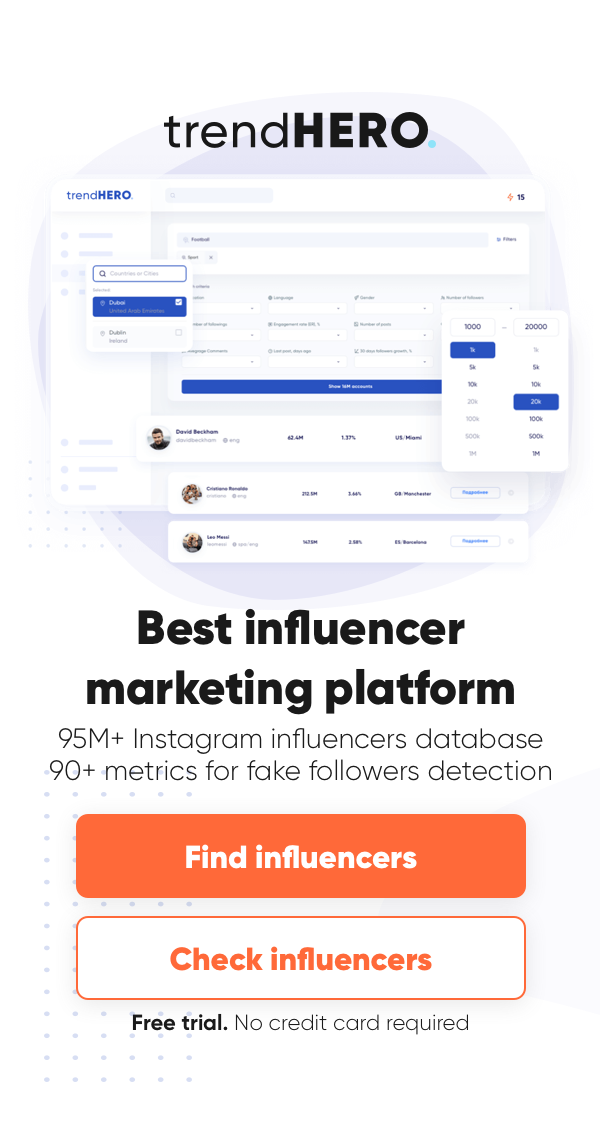- Home
- BLOG
- Instagram Business
- How to Create a Winning Social Media Proposal to Secure New Clients
Landing a new client is no easy task, especially in the competitive world of social media marketing.
Regardless of your approach to client prospecting and discovery, all roads lead to one document: the business proposal. Here, you pitch your services, set out goals, and formulate a timeline for your client’s needs.
According to research by process.st, if you send a business proposal within 24 hours of reaching out to a client, you’re likely to see a 25.9% sales conversion rate.
So, whether you’re an independent social media influencer or a marketing agency, nailing the business proposal is a must. Without it, you’ll fail to communicate your ideas in a transparent, trustworthy manner. Your prospects will turn to competitors and you won’t be able to scale your business effectively.
Having a basic proposal template at the ready is a no-brainer (see the PandaDoc commercial proposal example). Beyond this, it’s also useful to understand what questions to ask so that you may tailor each proposal to the specific client.
Looking to get started? This article will help you write a social media proposal, with tips for the process, and a basic outline to follow.
What is a social media proposal?
A social media proposal is a business proposal relating to social media management, marketing, or consulting.
In this document, you explain how your services can help a prospective client achieve their social media goals. While this isn’t a legal contract, prospects will expect to see a rough timeline of events as well as a basic pricing structure.
But what else goes into a social media proposal, and how can this boost your prospect conversion rate?
To understand what makes a winning social media proposal, think of its position in the context of the wider sales process. This may be summarized as follows:
- Prospecting phase: This is the process of searching for qualified leads, finding ideal customers who want your company’s services. This is achieved through either inbound channels (e.g. asking clients to fill in a form on your landing page), or outbound channels (e.g. directly speaking to prospects on social media platforms).
- Discovery phase: Here, you learn about your client’s social media goals and current business strategy. Usually, this will be done in a Q&A style meeting.
- Proposal: The point at which your strategic suggestions are codified into a single formal document.
So when we talk about writing a winning social media proposal, we mustn’t overlook the importance of the prospecting and discovery phases. If you’re not searching for the right prospects, or are asking them irrelevant questions, your proposal is unlikely to secure a new client. Bear this in mind as we cover the steps for creating a winning proposal.
5 steps for creating a winning proposal
We know that proposals require thought before it comes to the writing phase. So, what sort of information do you need to learn beforehand?
Understand the prospect’s goals
First, work out what the prospect wants. This helps you craft a proposal that fits their exact needs.
You need to work out:
- How large their business currently is (net income, number of clients)
- What their ambitions are
- What challenges they have faced in achieving this
Work out their target audience
Social media strategies work by pushing the right content to the right people.
You can do neither if you have no idea who a prospect’s target audience is. You should begin building a persona of their average customer, working out details like:
- Their age and gender
- Preferred social media platforms (e.g. LinkedIn, Facebook, TikTok)
- Where they live
- How much they earn, their job, or sector
Once you have collected these details, you can create a style guide that connects with their target audience.

Study their competitors
Learning from competition achieves two things: it gives you ideas for your own strategy, and it acts as a benchmark for success.
Your first task is to learn who their main competitors are. This can be accomplished in the discovery Q&A session.
Next, you need to learn what their competitors are doing right. What type of social media strategy are they pursuing? Which content formats and platforms do they use? What demographics are they targeting?
Audit their current social media strategy
The next step is to evaluate the prospect’s current social media strategy.
That means conducting a social media audit of the platforms they use, the type of content they produce, and their post frequency. You may also want to look at social media ads they have run in the past.
Doing this achieves many things:
- You will know what has and hasn’t worked for them
- You can identify areas for improvement (what your services will provide)
- It proves that you are serious about them achieving their goals
Learn about their expected timeline/budget
Finally, you need to figure out the prospect’s preferred budget and timeline of events.
You can ask these questions during the discovery phase and Q&A section. If you’d prefer not to be so direct, stick to broad questions, such as what their overall marketing budget is. Then you can offer a plan that falls within that scope.
This will help you set goals that are realistic to their investment strategy.
Writing the proposal: your checklist
The report by process.st found that the ideal business proposal length is six pages.
So, that’s six pages to sell your services to prospective clients – what should you include?
Introduction
The introduction is probably the most important section of your proposal.
It’s the first section the prospect will read. If you can’t construct a compelling narrative here, chances are it will also be the last section they read!
In recruiting contracts like the PandaDoc freelance recruiter agreement you might get straight into the legal details. However, with a business proposal, you want to open with a gripping piece of text as a ‘hook’ for the prospect to continue reading.
After this, you should focus on their business and their needs. After all, this is what they really care about – not the core mission and history of your own venture.
Detailed specification of services
Once you have their attention with a short and gripping introduction, you can talk about the real substance of the proposal.
Cover the scope of the work that you provide, the sorts of content that you can produce, and the schedule that you’d follow.
Here, it’s also appropriate to talk about your expected communication with the client. How often would you hold strategy sessions? What mechanisms would you use for transparent reporting of their KPIs?
Expected timeline and goals
Now, talk about what those services would achieve for their business.
Stick to realistic targets that you will be able to deliver on, or you’ll set yourself up for disappointment.
Your prospect will want to know all about the actions you’ll take from day one. So, give them timescales for how long campaigns will take to start (e.g. consulting and filming phases), and how often you expect to publish new content.
Integrate this into your strategy for communication. How will you keep track of progress and report it to them?
Assurance for the client
Making promises to your prospect is great, but they are worthless if you can’t substantiate them.
You need to prove that you will deliver. Use case studies from previous clients – what their goals were, what you achieved etc. This personal touch stands out from long lists of analytics and legal jargon, giving your proposal a human aspect.
From here, you can devise a minimum guarantee of social media goals to be met.
Pricing structure
Developing a pricing structure is one of the most challenging tasks of the process.
It is unique to every prospect: their goals, expectations, company size, industry, and location, to name just a few factors. It is also extensive since you must list all relevant services and costs (handing out hidden fees later on is a bad look).
Not only that, but your business must remain competitive. That means you need to research the market rate for your services, finding a happy medium that provides you with sufficient revenue.

Next steps
So, you have told the prospect the main points and hopefully they wish to proceed with your proposal.
Next, you need to agree with the client on the exact wording of the proposal. Are they happy with every section, or do they want an expanded/reduced service? Make sure to communicate promptly and underline your willingness to revise targets or payment as necessary.
Once the proposal has been agreed upon verbally, you will need to request a signature and initial payment.
Terms and conditions
Finally, you should include a section at the end for their lawyers to check.
This sets out each party’s responsibilities and liabilities. Obviously, you will provide the services promised, and they will make the necessary payments. It should also include agreements for billing practices and the eventual termination process.
Additional considerations here might include a clause on commissions, ensuring you will be remunerated for a successful campaign.
Creative rights are another important topic, clarifying the legal owner of the social media material. You may want to follow this NDA agreement guide from PandaDoc to inform your position on intellectual property. For example, ensure that they won’t replicate your materials and processes for future marketing agencies.
Conclusion
This article has covered the process for creating a social media proposal, from the first steps to the writing of the agreement itself. By now, you know which questions to consider at each step, as well as best practices for the process.
Once your template is ready, nothing holds you back from crafting personalized social media proposals that deliver on converting leads. Make sure you track emails and have notifications alerts on, so you can respond to incoming leads promptly. Good luck!
 | Yauhen Zaremba Director of Demand Generation Yauhen is the Director of Demand Generation at PandaDoc, an all-in-one document management tool for almost all types of documents, including this rental lease agreement template. He’s been a marketer for 10+ years, and for the last five years, he’s been entirely focused on the electronic signature, proposal, and document management markets. Yauhen has experience speaking at niche conferences where he enjoys sharing his expertise with other curious marketers. And in his spare time, he is an avid fisherman and takes nearly 20 fishing trips every year. |
We also recommend to read
Instagram Engagement Rate Calculator For Free
Check any influencer's Engagement rate and analyze his or her followers growth history
Other free tools: Follower Count History, Instagram Follower Count, CPM Calculator






